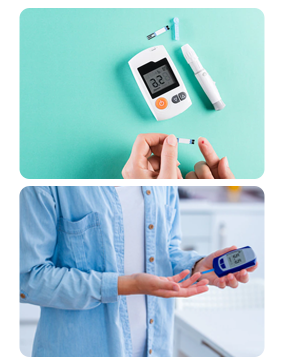What Is Diabetes and How to Test for It?

Diabetes is a condition that affects about one in ten American adults, and it is the seventh-leading cause of death in the country. Despite being so common, though, there is still a lot of confusion surrounding what diabetes is, what causes it, and how it is diagnosed. This confusion is compounded by the fact that there are two distinct types of diabetes, each with its own unique treatment and cause.
In this guide to diabetes, we’ll cover all of these important topics along with everything else you need to know about diabetes and diabetes testing.
What is Diabetes?
Understanding what diabetes is starts with understanding how the body converts the food you eat into energy. This begins with the digestive system breaking down food into a type of sugar called glucose, which is then released into the bloodstream. The blood carries glucose to cells throughout the body where it is then used as fuel and converted into energy. Before glucose can be released from the bloodstream into cells, though, the pancreas (which is a gland located behind the lower part of the stomach) must first produce and release insulin. You can think of insulin as a sort of key that lets glucose into cells, and, without it, glucose simply remains in the bloodstream, unable to be used.
This brings us to diabetes, which is a condition that causes the pancreas to not produce enough insulin and/or causes the body to not properly utilize the insulin that is produced. This results in high blood sugar levels and can lead to a range of symptoms and complications, including:
- Eye problems such as diabetic retinopathy
- Sores and cuts that won’t heal
- Damaged blood vessels leading to heart attack and stroke
- Gum disease and other mouth problems
- Nerve damage
- Increased cancer risk
- Sexual issues in both men and women due to reduced blood flow to the genitals
If left untreated, diabetes can also cause a potentially life-threatening condition known as diabetic ketoacidosis (DKA). This condition occurs when cells that are starved for energy begin to break down fat cells in order to produce it, resulting in the production of toxic acids called ketones that can lead to a coma or death.
The Difference Between Type 1 and Type 2 Diabetes
Everything that we’ve covered so far applies to both type 1 and type 2 diabetes, as both conditions cause the same problem and can lead to the same symptoms and complications. The biggest difference between type 1 and type 2 diabetes is what causes each condition. Type 1 diabetes is a genetic condition and is typically diagnosed at an early age. This type of diabetes causes the body’s immune system to attack insulin-producing cells in the pancreas, resulting in limited insulin production.
Type 2 diabetes, meanwhile, develops over time and is largely caused by poor diet and lack of exercise. Type 2 diabetes is caused by blood sugar levels that are too high for the pancreas to keep up. Many people with type 2 diabetes also develop insulin resistance, which makes the body unable to effectively use the insulin that the pancreas produces.
The second key difference between the two types of diabetes is how they are treated. Someone with type 1 diabetes will be required to take insulin for the rest of their lives since their pancreas no longer produces it. Someone with type 2 diabetes, on the other hand, may be able to manage their condition with medication and lifestyle changes intended to lower blood sugar levels.
The final noteworthy difference between the two types of diabetes is how common each type is. In the United States, type 2 diabetes is far more common than type 1, with type 2 diabetes accounting for about 90-95% of cases and type 1 diabetes accounting for the remaining 5-10%.
While we’re discussing different types of diabetes, it’s worth mentioning a third type of diabetes that doesn’t get nearly as much attention. This is gestational diabetes, which is a type of diabetes that occurs during pregnancy and usually goes away following childbirth. Even if it does go away, though, someone who is diagnosed with gestational diabetes is more prone to developing type 2 diabetes later in life.
How to Test for Diabetes
Physicians use blood tests to diagnose diabetes. These tests measure your blood sugar levels to determine if they are higher than they should be. If it’s suspected that a patient might have type 1 diabetes, then the physician will order an additional test to test for the presence of autoantibodies – the destructive immune system cells produced by those with type 1 diabetes.
As for who should get tested for diabetes, the American Diabetes Association recommends the following guidelines for diabetes testing:

- Anyone over the age of 35 should undergo an initial diabetes screening. If blood sugar levels are normal, they should be screened once every three years afterward.
- Anyone with a body mass index (BMI) over 25 (23 for Asian Americans) who also has additional risk factors such as high blood pressure, a family history of diabetes, an inactive lifestyle, non-typical cholesterol levels, a history of heart disease, or a history of polycystic ovary syndrome should undergo initial diabetes screening.
- Women who have had gestational diabetes are advised to undergo screening once every three years.
- Anyone who has been diagnosed with prediabetes is advised to undergo screening once a year.
- Anyone who has HIV is advised to undergo an initial diabetes screening.
At St, Jude Labs, diabetes screening is one of the many medical testing services that we are proud to offer. To schedule an appointment for diabetes testing at our state-of-the-art Maryland lab, be sure to contact us today!


